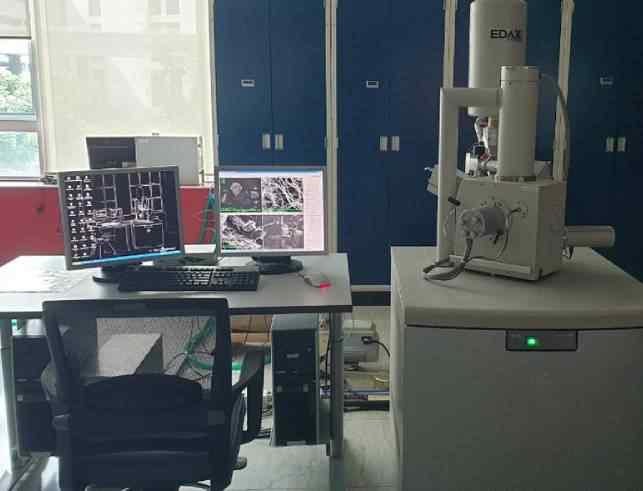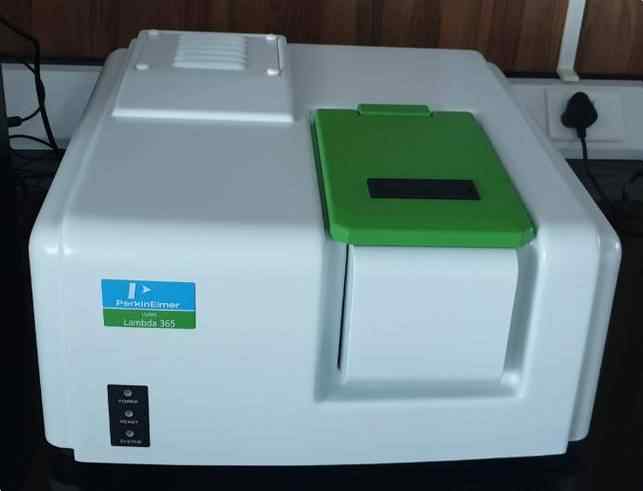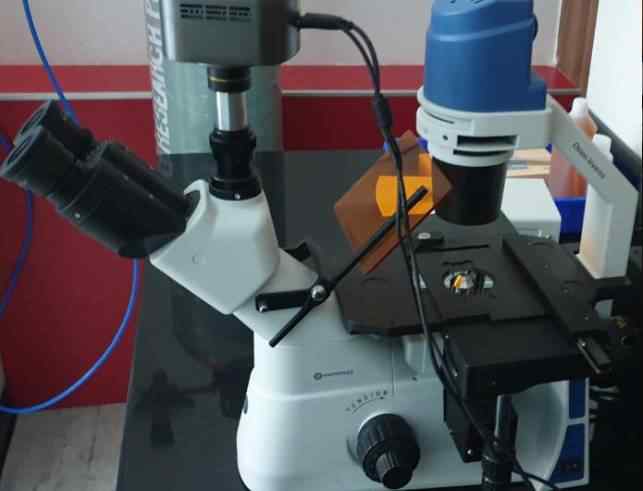
Imaging Lab
- Imaging Lab performs structural and morphological characterization along with quantitative and qualitative analysis of samples to understand their morphology, properties and chemical composition nature. The imaging lab currently consists of Scanning Electron Microscope with EDAX, Infrared Spectrometer, Uv-Visible spectrometer and Inverted Microscope.
The instruments that currently constitute the Imaging lab are as follows:
Scanning Electron Microscope and EDAX
The SEM is a type of electron microscope that images the sample surface by scanning it with a high-energy beam of electrons producing signals that contain information about the sample’s surface topography, composition and elemental identification. The types of signals generated by a SEM include secondary electrons (SE), backscattered electrons (BSE), characteristic X-rays and light.

Specification
- Instrument: Scanning Electron Microscope and EDAX
- Model: Quanta 200
- Manufacturer: FEI Company, USA
- Key features: FEI Quanta 200 environmental scanning electron microscope (ESEM) with EDAX system produces enlarged images with magnifications over 100000x, providing high-resolution imaging in a digital format. The EDS system attached to the SEM enables the elemental analysis of the samples. This SEM has a tungsten gun that is capable of true surface imaging at High-vacuum mode (10-2 to 10-4 Pa) for Conductive samples, simultaneous secondary electron (SE) and backscattered electron (BSE) imaging in Low-vacuum mode (10 – 130 Pa) for Nonconductive, mixed or contaminating samples and ESEM-vacuum mode (10 – 2600 Pa) for Wet samples in their natural state. Allows for in situ dynamic experiments.
Infrared (IR) Spectrometer
Infrared spectroscopic technology is on atomic vibrations of a molecule that only absorbs specific frequencies, which uses an interferometer to measure the relative energies of infrared radiation.
Specification
- Instrument: Infrared (IR) Spectrometer
- Model: Spectrum One FT-IR spectrometer.
- Manufacturer: Perkin Elmer, USA
- Key features: FTIR spectroscopy measurements are performed over a broad spectrum range of 7800 to 370 cm-1. This instrument can operate in ratio, single-beam, or interferogram mode. It includes a mid-infrared detector – either DTGS (deuterated triglycine sulphate) or LiTaO3 (lithium tantalate) – as a standard, and the option of using MCT (Mercury Cadmium Telluride) or PAS (a photo-acoustic detector). This instrument minimizes the effect of atmospheric water and CO2 on the sample spectra without the need for reference or calibration spectra.

UV-Visible Spectrometer
UV-Vis spectroscopy measures the amount of discrete wavelengths of UV or visible light, that are absorbed by or transmitted through a sample in comparison to a reference sample. It follows the Beer-Lambert law and uses the photomultiplier tube as the detector.

Specification
- Instrument: UV-Visible Spectrometer
- Model: Lambda 365 spectrometer
- Key features: This is a compact and modular instrument operated in the range of 190-1100 nm, Si diode as the detector, and double beam optics for high stability and low stray light. This has an extremely high signal-to-noise ratio. It is used for the quantitative determination of transition metal ions, highly conjugated organic compounds, biological macromolecules, nucleic acid concentration, thickness and reflectance/transmission of films.
Fluorescence Microscope
Specification
- Instrument: Fluorescence Microscope
- Model: Oxion Inverso – OX 2453-PLPHF
- About the instrument: Oxion Inverso is an inverted microscope and can be used for fluorescence imaging of materials and biological samples.

